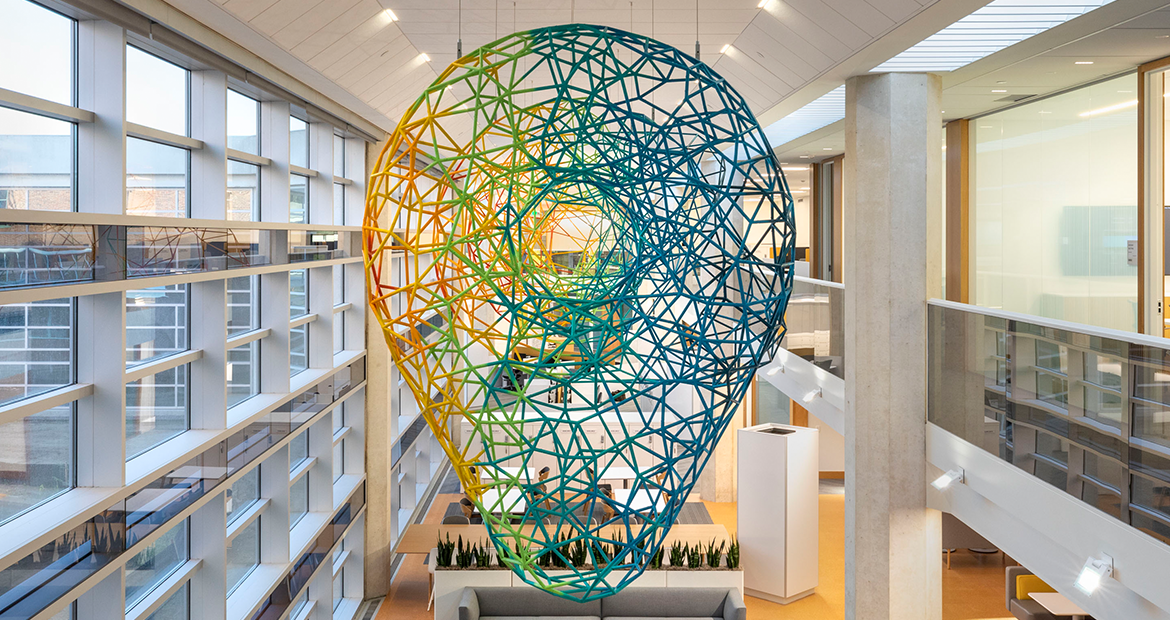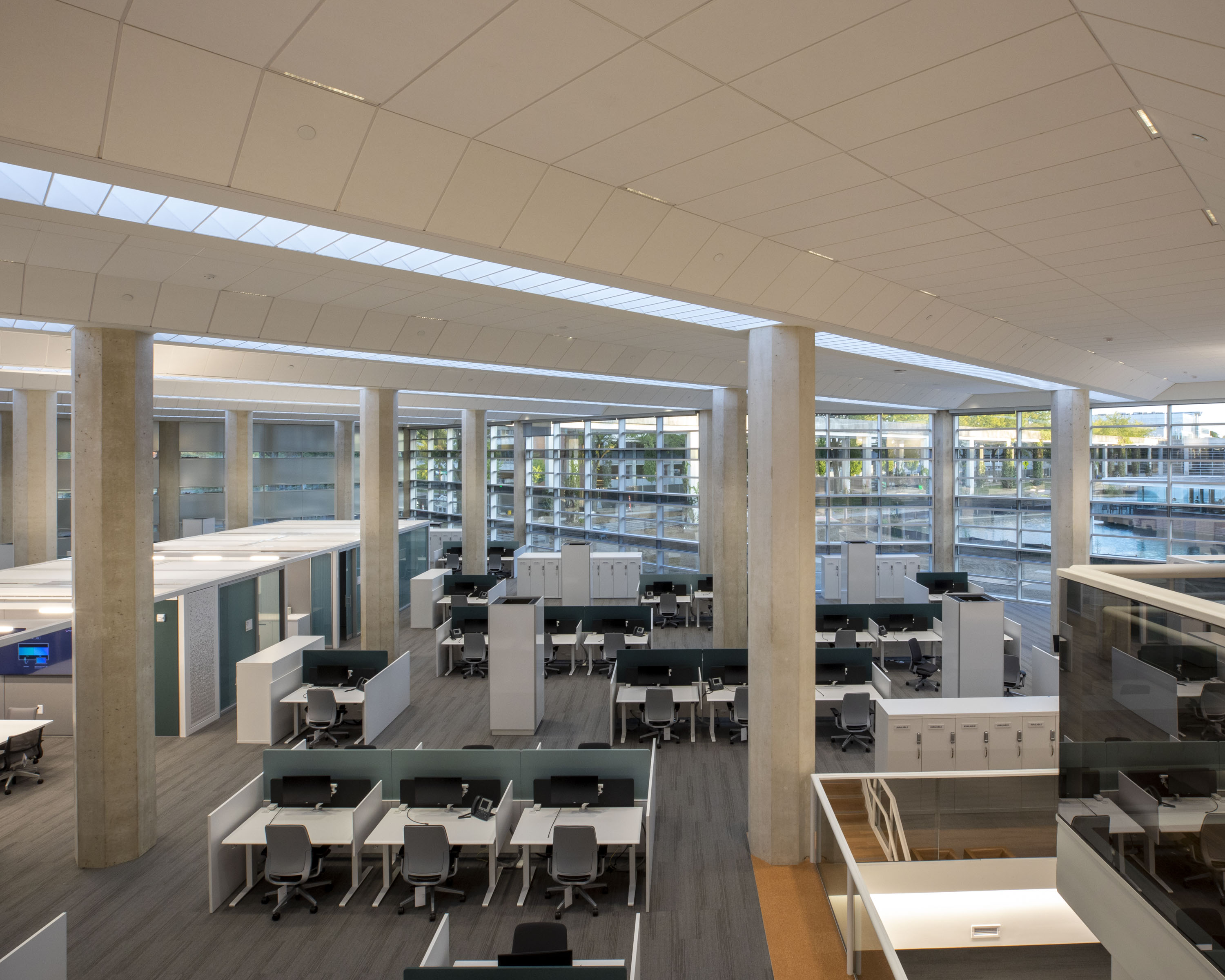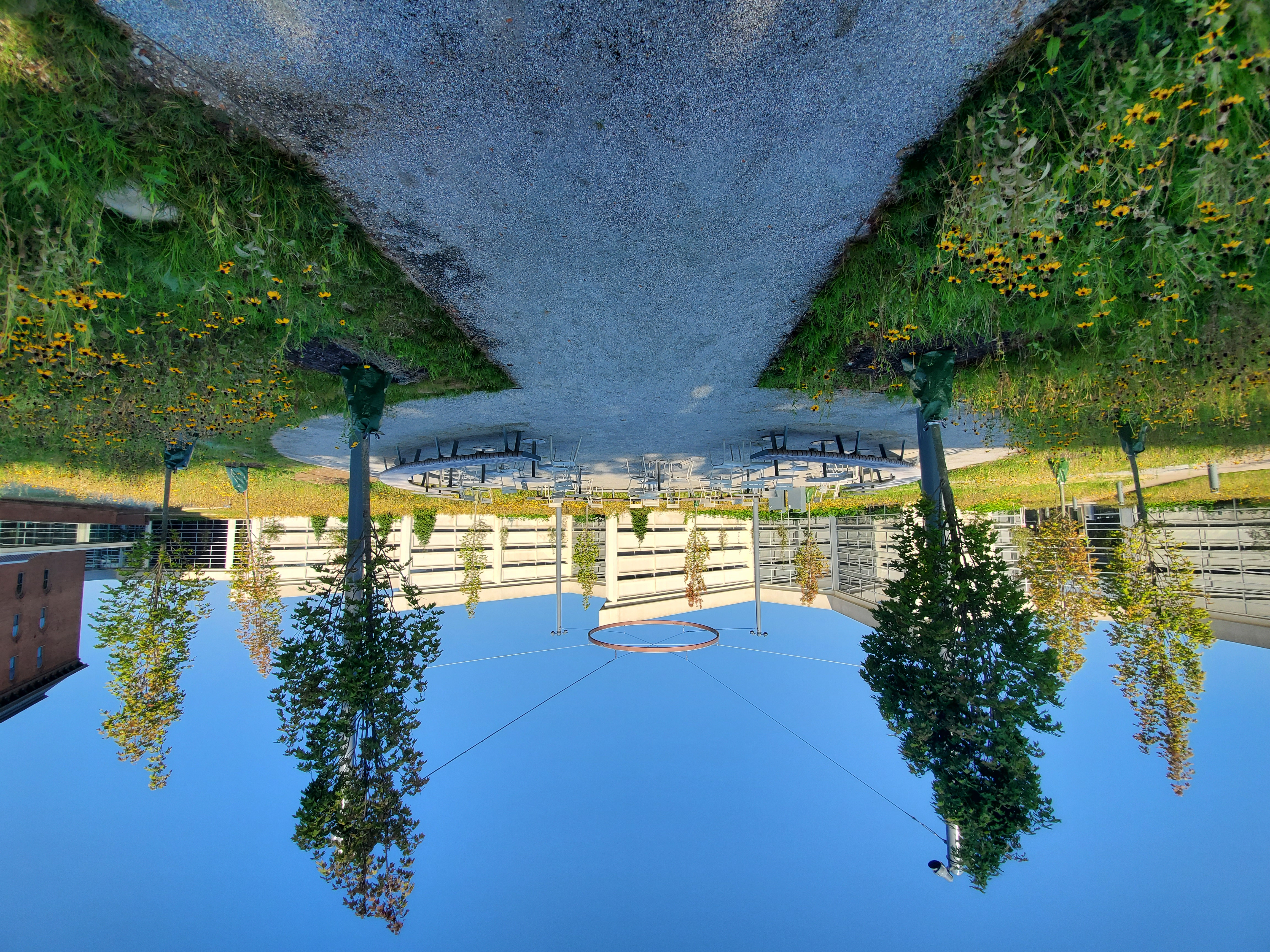Our newly renovated COB takes a short look back and a long look forward for the modern workplace
By Catherine Morgenstern, Brand Journalist

The modern workplace is evolving quickly. Across the world, our collective experiences with quarantines, working from home, and video conferencing has changed the way we all work together. As we look to the future, many employees may have a hybrid schedule or even have a designated workspace. How can the post-COVID office best support these new ways of working? For Cummins employees at the company’s global headquarters in Columbus, Indiana, colloquially called “The COB,” the answer is already here.
Originally designed by Pritzker Prize-winning architect Kevin Roche, the COB was erected in 1983 and has historically held up to 1,200 employees. Renovations on the building began in Fall 2017 with areas south of the cafeteria, and the now-complete north-end welcomes employees with a variety of work settings for individual or collaborative work, lots of natural light, and interactive outdoor areas.
“At the start of the project in 2017, we knew we wanted to implement the Cummins Smart Office strategy—flexible workspaces, lots of collaboration space, social spaces, and not many assigned desks. This is exactly what the post-Covid workplace needs to be,” said Josh Duncan, Indiana Campus Manufacturing & Tech Facilities Leader.
The COB was designed during energy crisis in the 1970s, so energy efficiency was one of the main drivers of the design. With few exceptions, the only exterior glass was north facing, and views to the outdoors were limited. The main source of light for much of the building was skylights, which posed a problem on cloudy days. Mirrors were intended to disperse light, but many people found them to be disorientating at times.
“The labyrinth of cubicles and mirrors made it difficult to find your way around. The mauve and beige palette, while appropriate for the time, was dated. Of the 1200 people assigned to the building, as many as 300 were in the basement. Those are all things that we wanted to address with the renovation,” added Josh.
The American Institute of Architects ranked Columbus sixth in the nation for architectural innovation and design – right behind Chicago, New York, Boston, San Francisco, and Washington, D.C. The reason for Columbus’ recognition in this category can be traced directly to Cummins, and specifically J. Irwin Miller’s investment in the city. In 1957, Miller made an offer that the Cummins Foundation would pay all the architect fees for new public buildings in Columbus, attracting world renowned architects such as I.M. Pei, Richard Meier, Robert Venturi, Eliel and Eero Saarinen, Harry Weese, Deborah Berke and Kevin Roche, who designed the COB.
“I live and work in Columbus, and I've always appreciated the architectural history of the city and the COB. Because architecture is intended to reflect current culture, the updates made to the COB support the way we need to work today, with many collaborative work spaces and inspiring, bright areas for everyone,” said Jennifer Rumsey, President and Chief Operating Officer of Cummins Inc. “My thanks to all involved with the renovation and our continued efforts to make our workspaces welcoming environments.”
Cummins continues its commitment to Columbus with the newest improvements to its COB. Check them out below!
Natural Light and Views
What is called The Town Square is an open, common social area with great views to the Cerealine building and new, interactive landscape. There are many windows, lounge seating, and social areas for employees to enjoy. An original sculpture is suspended from the ceiling, representing an engine’s camshaft.
Throughout the building, natural light has been maximized through the addition of many energy efficient, exterior window walls all around the park area, greatly increasing the views to the exterior and natural light in the space.

Landscape
“The former landscape was of a distinct era in American commercial culture; monumental, symbolic, and intensive in maintenance. The new landscape is both socially and environmentally sustainable, but demonstrably an expression of Cummins’ interest in expanding the creativity of its people so that they can choose where they will be most thoughtful and productive,” said David A. Rubin, founding principal of DAVID RUBIN Land Collective, who designed the updated outdoor areas of the COB.
One of those outdoor areas is a circular work area with benches and chairs, called The Launchpad, as well as two new entrances to the park from the building.

The new landscape is now only about 20% lawn, with the rest a combination of perimeter plantings and a meadow mix. This sustainable approach to landscape design needs significantly less irrigation or regular mowing, and provides a natural habitat for butterflies and birds.
Workspace transformation
Before the renovation, the building had capacity for about 1200 people with 300 people assigned to the basement. The new COB still has capacity for 1200 people, but workstations are no longer in the basement. The basement is now used as our largest conference center, with many large meeting rooms. These were in short supply prior to the renovation.
Open, visible stairs were added to connect all three levels of the building in one area. Energy efficient LED lights keep everything well-lit and vibrant.

The renovation added a convenient bridge to the second story of the historic Cerealine building, which was once a grain mill that produced a breakfast cereal featured on the menu of the Titanic. The Cerealine building now has a deck for outdoor dining with great views of the pond and fountains.
Artwork
Artwork has been an integral element of the COB since its inception, and this has been re-invigorated with the renovation. Due to the Miller’s patronage of mid-century art, the building already had a world class art collection with many artists now considered masters of the time, such as Wassilly Kandinsky, Josef Albers, and Richard Anuszkiewicz. The design team continued this tradition by including new art selections, by artists such as Paul Villinski, an American best known for his large-scale installations of individual butterflies made from aluminum cans found on the streets on New York City.

The COB lobby has also been completely reimagined.
“Before, the lobby was also a museum—for an engine company, but Cummins does so much more than that now, between all of our components and new power products,” said Josh. “We undertook a big project with the designer to create a space that would be a ‘short look back and a long look forward.’”
The result is a new space that still celebrate our history, but also tells the story of Cummins’ commitment to the Stakeholder Model: employees, customers, and communities are all represented in the new space.
Hanging up on the wall is a Cummins powered RAM D250 pickup, one of the first to be powered with a Cummins engine.
Part of the space is intended to be flexible and dynamic. The flexible space currently features an exhibit about Cummins history with racing.
Author Profiles

Catherine Morgenstern, Brand Journalist
Catherine Morgenstern is a Brand Journalist for Cummins, covering topics such as alternative propulsion, digitalization, manufacturing innovation, autonomy, sustainability, and workplace trends. She has more than 20 years of experience in corporate communications, holding leadership positions most recently within the Industrial Capital Goods sector. Catherine began her career as a marketing writer for a biotechnology company, where she learned to take complicated and highly technical information and make it accessible to everyone. She believes the concept of “storytelling” is more than a trendy buzzword and loves to find ways for her readers to make personal connections to her subjects. Catherine has a passion for technology and innovation and how its intersection can make an impact in all our lives. Catherine recently moved back to her hometown in the Hudson Valley, New York after a several decades in Los Angeles and Chicago. She is a graduate of UCLA and enjoys gardening and spending time with her husband and three children.
Related Tags